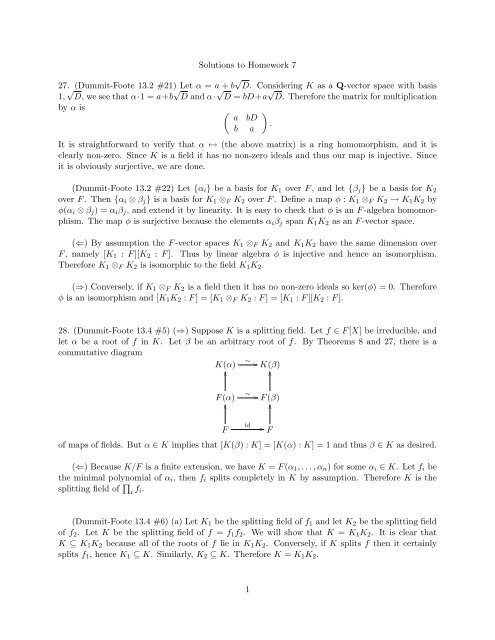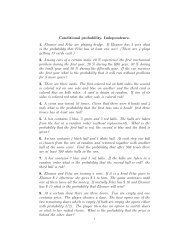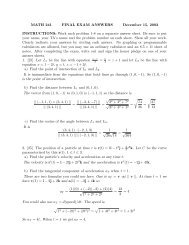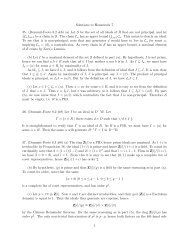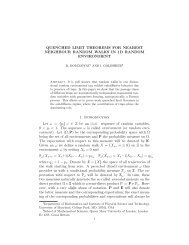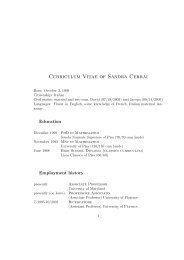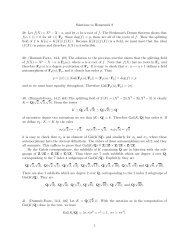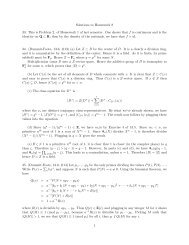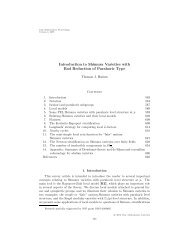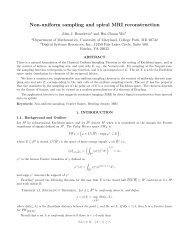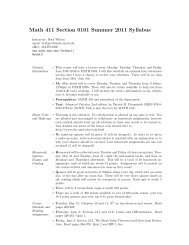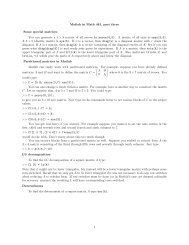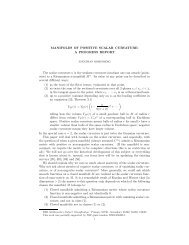Solutions to Homework 7 27. (Dummit-Foote 13.2 #21) Let α = a + b ...
Solutions to Homework 7 27. (Dummit-Foote 13.2 #21) Let α = a + b ...
Solutions to Homework 7 27. (Dummit-Foote 13.2 #21) Let α = a + b ...
Create successful ePaper yourself
Turn your PDF publications into a flip-book with our unique Google optimized e-Paper software.
<strong>Solutions</strong> <strong>to</strong> <strong>Homework</strong> 7<br />
<strong>27.</strong> (<strong>Dummit</strong>-<strong>Foote</strong> <strong>13.2</strong> <strong>#21</strong>) <strong>Let</strong> α = a + b √ D. Considering K as a Q-vec<strong>to</strong>r space with basis<br />
1, √ D, we see that α·1 = a+b √ D and α·√D<br />
= bD+a √ D. Therefore the matrix for multiplication<br />
by α is ( a bD<br />
b a<br />
It is straightforward <strong>to</strong> verify that α ↦→ (the above matrix) is a ring homomorphism, and it is<br />
clearly non-zero. Since K is a field it has no non-zero ideals and thus our map is injective. Since<br />
it is obviously surjective, we are done.<br />
)<br />
.<br />
(<strong>Dummit</strong>-<strong>Foote</strong> <strong>13.2</strong> #22) <strong>Let</strong> {α i } be a basis for K 1 over F , and let {β j } be a basis for K 2<br />
over F . Then {α i ⊗ β j } is a basis for K 1 ⊗ F K 2 over F . Define a map φ : K 1 ⊗ F K 2 → K 1 K 2 by<br />
φ(α i ⊗ β j ) = α i β j , and extend it by linearity. It is easy <strong>to</strong> check that φ is an F -algebra homomorphism.<br />
The map φ is surjective because the elements α i β j span K 1 K 2 as an F -vec<strong>to</strong>r space.<br />
(⇐) By assumption the F -vec<strong>to</strong>r spaces K 1 ⊗ F K 2 and K 1 K 2 have the same dimension over<br />
F , namely [K 1 : F ][K 2 : F ]. Thus by linear algebra φ is injective and hence an isomorphism.<br />
Therefore K 1 ⊗ F K 2 is isomorphic <strong>to</strong> the field K 1 K 2 .<br />
(⇒) Conversely, if K 1 ⊗ F K 2 is a field then it has no non-zero ideals so ker(φ) = 0. Therefore<br />
φ is an isomorphism and [K 1 K 2 : F ] = [K 1 ⊗ F K 2 : F ] = [K 1 : F ][K 2 : F ].<br />
28. (<strong>Dummit</strong>-<strong>Foote</strong> 13.4 #5) (⇒) Suppose K is a splitting field. <strong>Let</strong> f ∈ F [X] be irreducible, and<br />
let α be a root of f in K. <strong>Let</strong> β be an arbitrary root of f. By Theorems 8 and 27, there is a<br />
commutative diagram<br />
K(α)<br />
∼ K(β)<br />
F (α)<br />
∼<br />
F (β)<br />
F<br />
id<br />
of maps of fields. But α ∈ K implies that [K(β) : K] = [K(α) : K] = 1 and thus β ∈ K as desired.<br />
(⇐) Because K/F is a finite extension, we have K = F (α 1 , . . . , α n ) for some α i ∈ K. <strong>Let</strong> f i be<br />
the minimal polynomial of α i , then f i splits completely in K by assumption. Therefore K is the<br />
splitting field of ∏ i f i.<br />
F<br />
(<strong>Dummit</strong>-<strong>Foote</strong> 13.4 #6) (a) <strong>Let</strong> K 1 be the splitting field of f 1 and let K 2 be the splitting field<br />
of f 2 . <strong>Let</strong> K be the splitting field of f = f 1 f 2 . We will show that K = K 1 K 2 . It is clear that<br />
K ⊆ K 1 K 2 because all of the roots of f lie in K 1 K 2 . Conversely, if K splits f then it certainly<br />
splits f 1 , hence K 1 ⊆ K. Similarly, K 2 ⊆ K. Therefore K = K 1 K 2 .<br />
1
(b) We will use the previous exercise. <strong>Let</strong> f be a polynomial with a root α in K 1 ∩ K 2 . Then<br />
α ∈ K 1 and α ∈ K 2 and because each of these is a splitting field, all of the other roots of f must<br />
be in both K 1 and K 2 . Therefore f splits completely in K 1 ∩ K 2 , which proves that K 1 ∩ K 2 is a<br />
splitting field.<br />
30. <strong>Let</strong> ζ = √ 2/2 + i √ 2/2, then ζ is a primitive eighth root of unity. If<br />
8√<br />
2 denotes the real<br />
positive eighth root of 2, then K = Q( 8√ 2, ζ) = Q( 8√ 2, i). As Q( 8√ 2) ⊆ R, we have i ∉ Q( 8√ 2) so<br />
Q Q( 8√ 2) K. Since [Q( 8√ 2) : Q] = 8 and [K : Q( 8√ 2)] = 2, we have [K : Q] = 8 · 2 = 16.<br />
31. <strong>Let</strong> f ∈ K[X 1 , . . . , X n ] and suppose f is in the intersection of all of the maximal ideals of<br />
K[X 1 , . . . , X n ]. Then 1 + fg is a unit (hence in K × ) for all g ∈ K[X 1 , . . . , X n ]. Setting g = 1 we<br />
have that f must be constant, and as it is contained in every maximal ideal, we must therefore<br />
have f = 0.<br />
32. We have a <strong>to</strong>wer of fields K ⊆ K(a 2 ) ⊆ K(a). The degree [K(a) : K] is equal <strong>to</strong> the degree of<br />
the minimal polynomial of a, which is odd. By multiplicativity of degrees of field extensions, we<br />
see that [K(a) : K(a 2 )] must also be odd. However, a satisfies the polynomial X 2 − a 2 ∈ K(a 2 )[X]<br />
which is degree two. Therefore [K(a) : K(a 2 )] ≤ 2, so we have [K(a) : K(a 2 )] = 1 and thus<br />
K(a) = K(a 2 ).<br />
2


